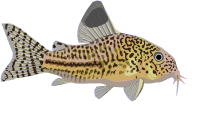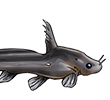Leporacanthicus cf_galaxias eating silicone
- Firestorming
- Posts: 241
- Joined: 09 Jan 2008, 23:11
- My cats species list: 27 (i:0, k:0)
- Location 1: NSW, Australia
- Location 2: NSW, Australia
Leporacanthicus cf_galaxias eating silicone
I recently stepped into the realms of keeping Leporacanthicus cf_galaxias , and thought I was well prepared until I found a report of them eating (or just destroying) the silicone that holds the tank together.
If anyone has experienced this, could you please provide me some preventative measures to stop them, I have an individual fish at this stage, but am tracking down some more in the hope of breeding them. I have a spare 6x2x2 tank they will eventually go into, at this stage I am thinking of glueing acrylic strips over all the joins to provide a barrier.
If anyone has experienced this, could you please provide me some preventative measures to stop them, I have an individual fish at this stage, but am tracking down some more in the hope of breeding them. I have a spare 6x2x2 tank they will eventually go into, at this stage I am thinking of glueing acrylic strips over all the joins to provide a barrier.
Motorcycles are not an expensive hobby, try keeping L-cats in Australia
- MatsP
- Posts: 21038
- Joined: 06 Oct 2004, 13:58
- My articles: 4
- My images: 28
- My cats species list: 117 (i:33, k:0)
- My aquaria list: 10 (i:8)
- My BLogs: 4 (i:0, p:164)
- Spotted: 187
- Location 1: North of Cambridge
- Location 2: England.
Re: Leporacanthicus cf_galaxias eating silicone
The prevention, I think, is to give them food! ;)
Seriously, I have seen the damage a large group of (20-30 fish) did to their tank at Pier, but there seem to be no damage to my tank tho', where I have 4 large ones of the very ones from Pier.
I think it may be something they do when stressed and/or starved.
--
Mats
Seriously, I have seen the damage a large group of (20-30 fish) did to their tank at Pier, but there seem to be no damage to my tank tho', where I have 4 large ones of the very ones from Pier.
I think it may be something they do when stressed and/or starved.
--
Mats
- Cristoffer Forssander
- Posts: 603
- Joined: 22 Jan 2005, 12:40
- I've donated: $10.00!
- My images: 76
- My cats species list: 42 (i:2, k:0)
- My BLogs: 22 (i:25, p:834)
- Spotted: 25
- Location 1: Sweden, Karlstad
- Location 2: SWEDEN
- Interests: Plecos, South american C***L and so on...
Re: Leporacanthicus cf_galaxias eating silicone
They usualy attack te corners of the aquarium, so I have long piece of glas, glued with silicone in every aquarium where I have Lepos. It's seemes to be 100% safe from destroying the silicone.
I Have this with L264, L240, L241 and L91
Cristoffer
I Have this with L264, L240, L241 and L91
Cristoffer
Guardians Of Catfish
- Richard B
- Posts: 6952
- Joined: 11 Aug 2006, 13:19
- I've donated: $20.00!
- My articles: 9
- My images: 11
- My cats species list: 37 (i:0, k:0)
- My aquaria list: 4 (i:0)
- My BLogs: 2 (i:0, p:29)
- Spotted: 10
- Location 1: on the sofa, or maybe at work?
- Location 2: Warwickshire: UK
- Interests: Tanganyika Catfish, African catfish, Non-loricariid sucker-catfish.
Running, drinking, eating, sci-fi, stapelids
Re: Leporacanthicus cf_galaxias eating silicone
As Mats says, the ones at Pier really did some damage. I think this is related to stocking density & the continual scraping action of a lot of loricariids. I've not heard of this replicated to the same extent by hobbyists but obviously prevention is better than cure so some barrier to the silicone would be a good idea
Lou: Every young man's fantasy is to have a three-way.
Jacob: Yeah not with another fu**!ng guy!
Lou: It's still a three-way!
Hot Tub Time Machine: 2010
Jacob: Yeah not with another fu**!ng guy!
Lou: It's still a three-way!
Hot Tub Time Machine: 2010
- Shane
- Expert
- Posts: 4646
- Joined: 30 Dec 2002, 22:12
- My articles: 69
- My images: 162
- My catfish: 75
- My cats species list: 4 (i:0, k:0)
- My aquaria list: 4 (i:4)
- Spotted: 99
- Location 1: Tysons
- Location 2: Virginia
- Contact:
Re: Leporacanthicus cf_galaxias eating silicone
This genus feeds by using its long upper jaw teeth to scrape cracks in stones and wood for food. The fimbriae on the upper lip function as "whiskers" to taste/locate hidden food items.
Burgess (1994) theorized that these teeth were used to extract snails from their shells, and this may be the case for . Gut content analysis in however showed caddis flies and freshwater sponges.
As the aquarium's seams are the closest thing to a "crack" in most aquariums, my best guess is that they sometimes ruin the silicone by exploring this "crack" for food with those large upper jaw teeth. A thin substrate will help protect the seam from their attentions and a piece of rough surfaced stone or wood that they can "explore" may help as well.
-Shane
Burgess (1994) theorized that these teeth were used to extract snails from their shells, and this may be the case for . Gut content analysis in however showed caddis flies and freshwater sponges.
As the aquarium's seams are the closest thing to a "crack" in most aquariums, my best guess is that they sometimes ruin the silicone by exploring this "crack" for food with those large upper jaw teeth. A thin substrate will help protect the seam from their attentions and a piece of rough surfaced stone or wood that they can "explore" may help as well.
-Shane
"My journey is at an end and the tale is told. The reader who has followed so faithfully and so far, they have the right to ask, what do I bring back? It can be summed up in three words. Concentrate upon Uganda."
Winston Churchill, My African Journey
Winston Churchill, My African Journey
- MatsP
- Posts: 21038
- Joined: 06 Oct 2004, 13:58
- My articles: 4
- My images: 28
- My cats species list: 117 (i:33, k:0)
- My aquaria list: 10 (i:8)
- My BLogs: 4 (i:0, p:164)
- Spotted: 187
- Location 1: North of Cambridge
- Location 2: England.
Re: Leporacanthicus cf_galaxias eating silicone
I have plenty of wood in my tank, so that may be a factor as well.
--
Mats
--
Mats
- Firestorming
- Posts: 241
- Joined: 09 Jan 2008, 23:11
- My cats species list: 27 (i:0, k:0)
- Location 1: NSW, Australia
- Location 2: NSW, Australia
Re: Leporacanthicus cf_galaxias eating silicone
Thanks guys, sorry for the belated thanks, just getting back from 3 weeks in china, I will post some pics of what I spotted when I get back on a proper computer.
Motorcycles are not an expensive hobby, try keeping L-cats in Australia
-
fish fodder
- Posts: 151
- Joined: 24 Apr 2005, 20:54
- My images: 19
- My cats species list: 17 (i:0, k:0)
- My aquaria list: 1 (i:1)
- Spotted: 9
- Location 1: YORKSHIRE
Re: Leporacanthicus cf_galaxias eating silicone
I have two large L91 and they do the same thing, you can hear them attacking the silicone. I tend to agree with Shane. The softness of the silicone could resemble sponges or my theory, snails.
I doubt very much it's down to lack of food as mine have a better diet than myself.
I doubt very much it's down to lack of food as mine have a better diet than myself.







